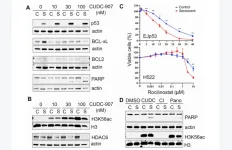(Press-News.org) Development of vaccines against SARS-CoV-2 has been rapid, but the rise of variants forces scientists to frequently modify treatments. Ideally, therapies would target mutation-resistant viral proteins, but this has proven difficult. Researchers reporting in ACS Central Science, however, have now developed a system that directly targets and degrades the viral RNA genome, reducing infection in mice. The method could be adapted to fight off many viruses, as well as treat various diseases.
Vaccines and antiviral drugs typically target proteins critical to viral infection and replication. This targeting induces evolutionary pressure for the virus to mutate, however, reducing the effectiveness of existing treatments and requiring development of new vaccines and drugs. To get around this issue, researchers have turned to targeting highly conserved structures within the viral RNA genome. Other groups have linked small molecule RNA binders to ribonuclease L ligands (RIBOTACs), creating degraders that relied on ribonuclease expression within cells, which varied across tissues. Avoiding this dependency, Gonçalo J. L. Bernardes, Konstantinos Tzelepis, Sigitas Mikutis and colleagues showed that attaching imidazole to RNA could degrade the nucleic acid, so they wondered whether attaching imidazole to an RNA-binding molecule would result in targeted degradation.
To accomplish this, the team used pyridostatin (PDS), which binds to G-quadruplex (G4) RNA structures, and MTDB, which binds to betacoronaviral pseudoknots, as the RNA-binding molecules. The researchers then appended each compound with a flexible linker and imidazole and called these molecules proximity-induced nucleic acid degraders (PINADs). By bringing imidazole into close proximity to the RNA, both PINADs degraded SARS-CoV-2 RNA. In addition, the compounds were effective when tested in cells infected with SARS-CoV-2 and its alpha and delta variants. Importantly, when the researchers gave the MTDB degrader to mice infected with SARS-CoV-2, viral load was reduced, as were levels of a biomarker of viral infection and replication. The researchers say that their system should allow any RNA-binding small molecule to be converted to a PINAD, so that it could someday be used to target and destroy other disease-related RNAs. This list could include disorders such as Alzheimer’s disease or Huntington’s disease, targeting the mRNAs of misfolded proteins that have otherwise proven difficult to target.
The authors acknowledge funding from the UK Research and Innovation (UKRI), the Wellcome Trust, the Jardine Foundation, the Cambridge Trust, the Agencia Estatal de Investigación, the UKRI Medical Research Council, Leukemia UK and Cancer Research UK.
The paper’s abstract will be available on April 26 at 8 a.m. Eastern time here: http://pubs.acs.org/doi/abs/10.1021/acscentsci.3c00015
The American Chemical Society (ACS) is a nonprofit organization chartered by the U.S. Congress. ACS’ mission is to advance the broader chemistry enterprise and its practitioners for the benefit of Earth and all its people. The Society is a global leader in promoting excellence in science education and providing access to chemistry-related information and research through its multiple research solutions, peer-reviewed journals, scientific conferences, eBooks and weekly news periodical Chemical & Engineering News. ACS journals are among the most cited, most trusted and most read within the scientific literature; however, ACS itself does not conduct chemical research. As a leader in scientific information solutions, its CAS division partners with global innovators to accelerate breakthroughs by curating, connecting and analyzing the world’s scientific knowledge. ACS’ main offices are in Washington, D.C., and Columbus, Ohio.
To automatically receive news releases from the American Chemical Society, contact newsroom@acs.org.
Follow us: Twitter | Facebook | LinkedIn | Instagram
END
Degrading viral RNA to treat SARS-CoV-2 infection
2023-04-26
ELSE PRESS RELEASES FROM THIS DATE:
U.S. adults who felt discrimination at work faced increased risk of high blood pressure
2023-04-26
Research Highlights:
U.S. adults who reported feeling highly discriminated against at work had an increased risk of developing high blood pressure than those who reported low discrimination at work.
Researchers suggest government and employer anti-discrimination policies and interventions may help to eliminate discrimination in the workplace.
Embargoed until 4 a.m. CT/5 a.m. ET Wednesday, April 26, 2023
DALLAS, April 26, 2023 — U.S. adults who reported feeling discriminated against at work had a higher risk for developing high ...
Innovative treatment targets blood clots without increased bleeding risk
2023-04-26
Safer and more effective blood thinners could be on the way following a groundbreaking discovery by researchers at UBC and the University of Michigan, published today in Nature Communications.
By combining their expertise in blood clotting systems and chemical synthesis, the researchers have designed a new compound called MPI 8 that offers the potential to prevent blood clots without any increased risk of bleeding—a common side effect of existing blood thinners.
“The development of MPI 8 represents a major breakthrough in the field of blood clot prevention and treatment,” said Dr. Jay Kizhakkedathu, a professor and Canada Research ...
Researchers show genetic basis of facial changes in Down Syndrome
2023-04-26
Researchers at the Francis Crick Institute, King’s College London and University College London have shed light on the genetics behind changes in the structure and shape of the face and head in a mouse model of Down Syndrome.
Described in a paper published today in Development, the researchers found that having a third copy of the gene Dyrk1a and at least three other genes were responsible for these changes taking place in development – called craniofacial dysmorphology – which involve shortened back-to-front length and widened diameter of the head.
Affecting ...
Gestational weight gain z scores, standardized by pre-pregnancy BMI, associated with susceptibility to autism-related traits
2023-04-26
ROCKVILLE, Md.—Gestational weight gain may be associated with autism-related behaviors among children who have a greater pre-disposition to these behaviors and who have mothers with pre-pregnancy overweight or obesity, according to a new study in Obesity, The Obesity Society’s (TOS) flagship journal.
Excessive gestational weight gain has been associated with neurodevelopmental outcomes in children, including autism spectrum disorder and related traits. However, it is unclear how pre-pregnancy body mass index (BMI) or familial susceptibility to autism spectrum disorder influences the gestational weight gain-autism traits association, ...
Longer siestas linked to higher risk of obesity, metabolic syndrome, and high blood pressure
2023-04-26
It is a common custom in some countries for individuals to take a siesta or midday nap. Sleeping during the middle of the day has the potential to affect sleep quality, cognitive function, and metabolic processes. However, the relationship between siestas and metabolic health is not well understood. A new study led by investigators from Brigham and Women’s Hospital, a founding member of the Mass General Brigham healthcare system, assessed more than 3,000 adults from a Mediterranean population, examining the relationship of siestas and siesta duration with obesity and metabolic syndrome. The researchers found that those who took siestas of 30 minutes or longer (long siestas) were more ...
The hidden power of Japanese food ― inhibiting the development of liver fibrosis
2023-04-26
Japanese food is popular worldwide and has been registered as a UNESCO Intangible Cultural Heritage. There is a scoring system named “the 12-component modified Japanese Diet Index (mJDI12),” which focuses on the intake of the Japanese diet pattern. It includes 12 foods and food groups: rice, miso soup, pickles, soy products, green and yellow vegetables, fruits, seafood, mushrooms, seaweed, green tea, coffee, and beef and pork. Scores range from 0 to 12, with higher scores indicating a diet that conforms to the Japanese food pattern.
A research group led by Dr. Hideki Fujii ...
Even as SARS-CoV-2 mutates, some human antibodies fight back
2023-04-26
LA JOLLA, CA—An anonymous San Diego resident has become a fascinating example of how the human immune system fights SARS-CoV-2. In a new investigation, scientists from La Jolla Institute for Immunology (LJI) have shown how antibodies, collected from this clinical study volunteer, bind to the SARS-CoV-2 "Spike" protein to neutralize the virus.
Although studies have shown antibodies bound to Spike before, this new research reveals how the original Moderna SARS-CoV-2 vaccine could prompt the body to produce antibodies against the later Omicron variants of SARS-CoV-2. The researchers ...
BioOne presents 2023 BioOne Ambassador Award to five early career scientists
2023-04-26
WASHINGTON, D.C., April 25, 2023 – BioOne proudly announces the 2023 recipients of the BioOne Ambassador Award. Now in its sixth year, this prestigious award recognizes early-career researchers in the biological, ecological, environmental sciences who demonstrate creative approaches to science communication thereby fostering greater science literacy and aiding in the understanding of the natural world. BioOne Ambassadors are nominated by BioOne publishing partners and each winning author will receive a $1,000 award, and have their work promoted through BioOne’s multiple channels.
This year’s ...
Characterization of the HDAC/PI3K inhibitor CUDC-907 as a novel senolytic
2023-04-26
“The mechanisms of induction of senescent cell death by CUDC-907 remain to be fully elucidated.”
BUFFALO, NY- April 25, 2023 – A new research paper was published in Aging (listed by MEDLINE/PubMed as "Aging (Albany NY)" and "Aging-US" by Web of Science) Volume 15, Issue 7, entitled, “Characterization of the HDAC/PI3K inhibitor CUDC-907 as a novel senolytic.”
The accumulation of senescent cells has an important role in the phenotypical changes observed in aging and in many age-related pathologies. Thus, the strategies designed to prevent these effects, collectively ...
Transparent labeling of training data may boost trust in artificial intelligence
2023-04-26
UNIVERSITY PARK, Pa. — Showing users that visual data fed into artificial intelligence (AI) systems was labeled correctly might make people trust AI more, according to researchers. The findings also may pave the way to help scientists better measure the connection between labeling credibility, AI performance, and trust, the team added.
In a study, the researchers found that high-quality labeling of images led people to perceive that the training data was credible and they trusted the AI system more. ...



